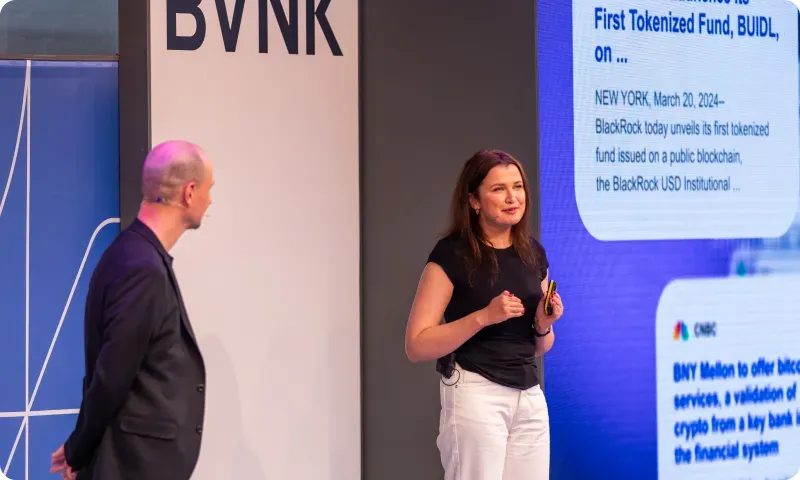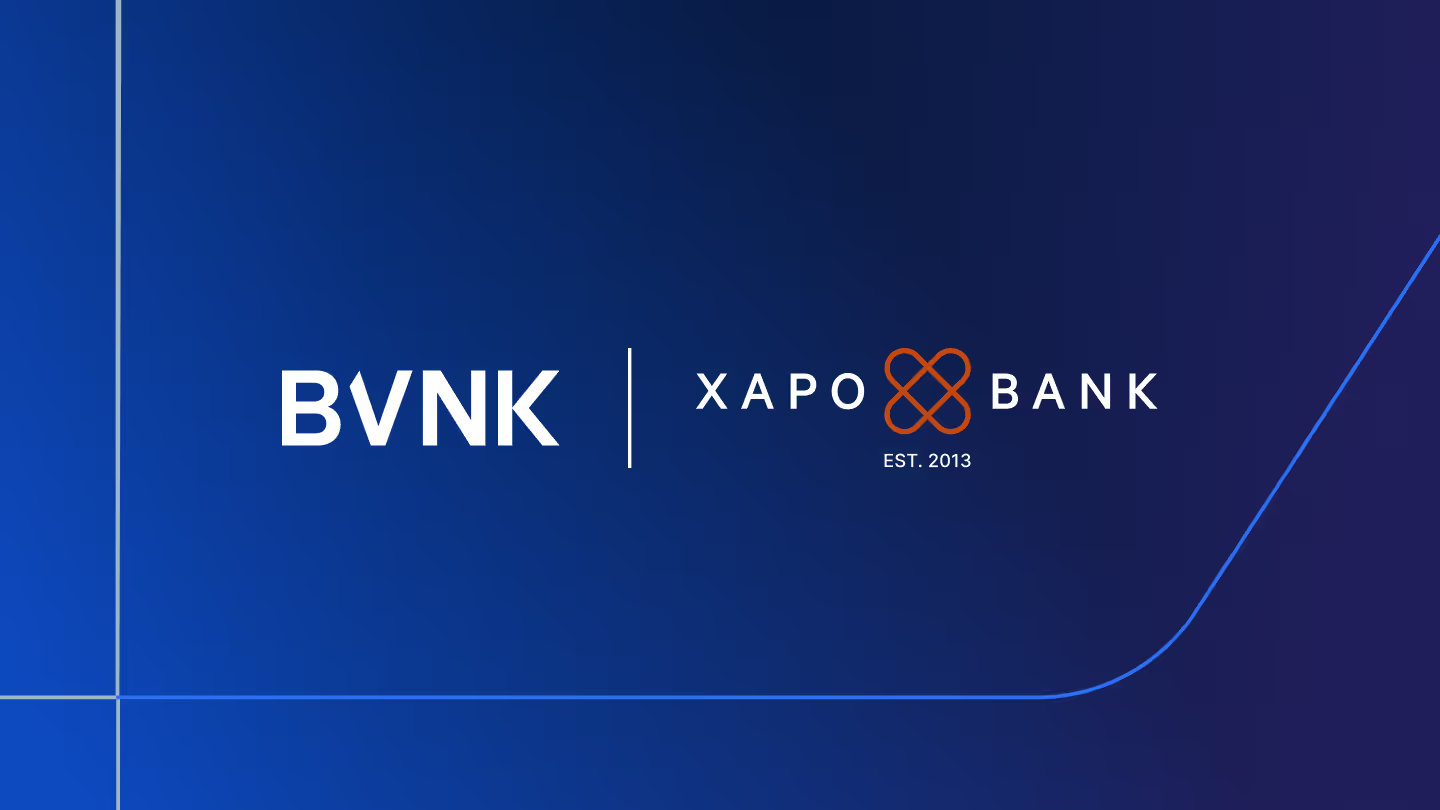How are stablecoins changing global money movement? 7 takeaways from Currency LDN 2024
Insights on global money movement from Chainalysis, FIS, Worldpay, PayPal Ventures, Standard Custody and BVNK.

We ventured into the future of money movement at Currency LDN 2024 this week, with leaders from Chainalysis, FIS, Worldpay, PayPal Ventures and Standard Custody.
Our focus was: bridging the gap. We shared real examples of fintech innovation at the intersection of traditional finance and blockchain, examined how stablecoins are becoming embedded in payments infrastructure, and compared crypto and fiat payments through the eyes of a financial crime compliance officer.
Here are our top takeaways from the day.
1. Stablecoins unlock economic efficiency.

The Centre for Economics and Business Research (Cebr) is conducting new research to examine how stablecoins unlock economic activity.
Chief Executive Nina Skero, commented: “Total stablecoin market cap is significant at over $160 billion, with the majority pegged to the US dollar. Businesses across the globe are demanding dollars, but some face restricted access. That can mean clunky, payment processes with friction, delay and cost, or sometimes just missed opportunities. With stablecoins, any business with access to the internet also has access to the digital dollar.”
Cebr identified 13 countries where businesses are willing to pay a premium to hold dollar stablecoins. Owen Good, Head of Economic Advisory at Cebr explained: “We believe one reason for this is that stablecoins are effective in mitigating the costs of the volatility. They help protect against cost uncertainty, particularly where businesses have a high share of imported goods or services for example, are locked into unfavourable exchange rates, or face constrained access to financing.”
Cebr also shared data on how stablecoins impact cross-border payment systems, releasing trapped working capital for businesses. Owen added “Where existing financial infrastructure is less developed, traditional cross-border settlement time can take up to five days. For any one transaction, it's not massively significant, but when you aggregate across all cross-border transactions, the volume of trapped capital becomes very meaningful."
2. B2B use cases for stablecoins are opening the door to B2C.
.avif)
Fintechs are already using stablecoins as a way to settle merchants. In 2022, Worldpay began offering merchants a portion of their settlements in USDC stablecoins. Caitlin Kulakowski, Director - Crypto at Worldpay commented: “We're seeing great return in terms of merchants who want this because they don't have bank account access, they want their funds faster, or they want cheaper cross-border fees.”
After completing a pilot with Visa to extend stablecoin settlement to another leg of the B2B payment journey, Worldpay has now turned its attention to B2C payouts.
Caitlin explained: “Consider a merchant like Etsy or Airbnb. They may have sellers and hosts globally, in places were there is currency volatility or where they just can’t get access to banking. We're offering them the ability to pay out in USDC. What’s really interesting is that this opens up stablecoins to non crypto-native merchants, who are now showing interest.”
BVNK Cofounder Chris Harmse added: “We’ve seen that our fintech partners often start with a B2B use case, as Worldpay did, driven by merchant demand. As they get comfortable with the infrastructure, they’re looking at how to enable consumer use cases like one-way remittance into emerging markets or B2C payouts for gig economy platforms.”
3. Stablecoin payroll is gaining traction.

Global payroll is emerging as a key use case for stablecoins. BVNK has launched a new product in collaboration with a major HR platform to enable near-instant payments for its global workforce.
Bernie Niebsch, Director of Product at BVNK, explained: “During Covid, remote employment skyrocketed. Many companies - BVNK included - hire talent globally, in places where they don’t have offices. They work with HR and Employer of Record platforms to figure out local employment law and contract those employees. But they have a problem: to pay these employees, they have to integrate dozens of PSPs and financial institutions.”
He added: “And if I'm a contractor for one of these platforms, I might see a balance in my account and want to take it out, but funds can take up to a week to arrive… our stablecoin payroll product addresses these challenges.”
In the first month with one global HR platform, 7,500 contractors have opted to be paid in stablecoins via BVNK's platform, with $11 million USD paid out.
4. Regulation has led to more institutional demand for stablecoins.

Standard Custody CEO Jack McDonald joined BVNK’s Ben Reynolds on stage to talk about Ripple’s plan to acquire Standard Custody and launch its own stablecoin.
Jack explained: “When you consider Ripple's global payments network, there's a broad global base of financial institutions who have increasingly been using stablecoins as a means of payment and a settlement token for that payment. Ripple wants to natively be a part of that.”
After launching Automated Market Makers (AMMs) functionality on its XRP ledger this year, Ripple is also seeing demand for a native stablecoin to be used as a pair trading. He added: “there’s a need for a stablecoin to facilitate liquidity there."
In a panel session that followed, we heard that the emergence of the regulated stablecoins, under the MiCA regime in Europe is enabling a host of use cases for financial institutions.
Julia Demidova, Head of CDBCs and digital assets at payments infrastructure provider FIS, commented:
“The MiCA regulation which comes into effect next month means that commercial banks, e-money institutions and credit institutions can all become issuers of stablecoins. It’s a great opportunity for them to tackle use cases like interbank transfers or cross-border payments, which could really enhance how money moves.”
Julia shared that FIS is also working with commercial banks outside Europe, including in the Middle East where stablecoin regulation is in the works, to support them in becoming issuers of regulated stablecoins.
5. With stablecoins, it’s not ‘winner takes all’.

The stablecoin market is expanding as trusted fintechs like PayPal and Ripple enter the space as issuers, alongside incumbents like Tether and Circle.
But this is not a ‘winner takes all’ scenario, said Standard Custody CEO Jack McDonald. “The rising tide lifts all ships… There's plenty of room for more high quality, liquid stablecoins… Ripple is looking to work with the Circles of the world and other issuers to benefit the industry. We’ve seen the massive economic impact that stablecoins are projected to have over time. Ripple wants to be a part of that equation.”
New stablecoins provide more choice for businesses and consumers, and can help to cater better for certain use cases, like payments, added BVNK Managing Director Ben Reynolds: “It's really difficult to use a stablecoin for a payment on the Ethereum blockchain for example, because gas fees are so high. So, it makes sense to have a stablecoin on a ledger like XRP or a chain that supports more efficient transaction costs.”
6. Fintechs entering the space should focus on banking relationships and licensing.

For fintechs looking to build products with stablecoins, banking and licensing are the biggest hurdles, said Worldpay’s Caitlin Kulakowski: “With licensing, you need to understand what you have and what you need in order to process in the countries where you want to process. Secondly, to get money on the blockchain, you need a banking relationship, and right now some banks are still a bit risk-averse. It’s important to have a clear approach across both these areas, and to lean on partners like BVNK to take some of the regulatory lift off of your shoulders.”
If you’re clear on your use case and audience, the most important thing is for fintechs to “be fearless,” added FIS’ Julia Demidova: “You need a very good understanding of what you're trying to solve, for who, and the commercial model for it... and you have to believe in what you're doing. If you’re driving for financial inclusion for example, that should be your goal, or if you want to reduce the cost of banking, that should be your focus. Then, you need to be fearless, and embrace regulation and compliance.”
7. Every financial institution has exposure to illicit activity… with crypto it’s easier to see the full picture

In our final session, we heard from Amardeep Thandi, Director, Crypto Regulatory and Compliance at Chainalysis, and Luke Dufour, Head of Financial Crime Intelligence at BVNK, on differences and similarities in AML compliance for crypto and fiat payments.
From his experience working in financial crime investigations in both banks and fintechs, Luke emphasised that money laundering typically cuts across financial worlds. “All banks and fintechs are exposed to this activity on some level,” he said, “and I haven’t seen a disproportionate amount of Suspicious Activity Reports (SARs) being filed on crypto activity versus fiat for example. There's often an intersect between the two – that tends to be how money launderers launder their money.”
A key difference with crypto though, is that it’s much easier to see and understand your exposure. This is where blockchain analytics come in, explained Chainalysis’ Amardeep Thandi, allowing you to “connect what's happening on the blockchain with real world services, and to understand who you're interacting with”. Analytics tools enable you to build a rich intelligence picture of your risk exposure – not just to your direct counterparty, but further back or forward in the chain, so you can build out your risk thresholds and controls accordingly.
He added: “Blockchain analytics protect the industry and ecosystem and enable it to thrive.”
Full session videos with all the insights from Currency LDN 2024, will be available soon on our Youtube channel and here on the BVNK blog.
Latest news
View allGet payment insights straight to your inbox



.jpg)






.avif)


.jpg)





